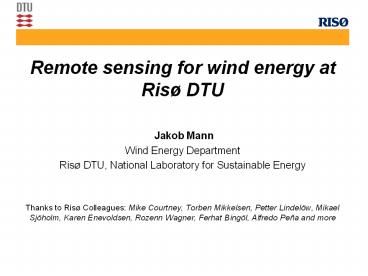Remote%20sensing%20for%20wind%20energy%20at%20Ris - PowerPoint PPT Presentation
Title:
Remote%20sensing%20for%20wind%20energy%20at%20Ris
Description:
Remote sensing for wind energy at Ris DTU – PowerPoint PPT presentation
Number of Views:145
Avg rating:3.0/5.0
Title: Remote%20sensing%20for%20wind%20energy%20at%20Ris
1
- Remote sensing for wind energy at Risø DTU
- Jakob Mann
- Wind Energy Department
- Risø DTU, National Laboratory for Sustainable
Energy - Thanks to Risø Colleagues Mike Courtney, Torben
Mikkelsen, Petter Lindelöw, Mikael Sjöholm, Karen
Enevoldsen, Rozenn Wagner, Ferhat Bingöl, Alfredo
Peña and more
2
Outline
- A very short history of remote sensing at Risø
- What kind of lidars do VEA-Risø own?
- Performance of lidar for wind power resources and
power curves - Other current uses of wind lidars at Risø
- The future The Windscanner project
- Conclusions and questions
3
A very short history of wind remote sensing at
Risø
- Why remote sensing?
- SODAR, SAR, kites, remotely controled aircrafts
- Early lidars bulky, expensive and not too stable
- 2003 QinetiQ ZephIR lidar. Compact, affordable
(?), relatively robust prototype - 2004? WISE experiment at Høvsøre
- 2006 QQ series production.
- 2006 Leosphere Wind Cube pulsed lidar
- 2007 January IEA Topical Expert meeting at Risø
State of the sodars, lidars, satellites. - Dec 2007 Musketters Experiment (3 crossing
lidars) - April 2008 Delivery of first modified
windscanner ZephiR - June 2008 RS Summer School and ISARS2008 at Risø
4
VEA lidars The QinetiQ ZephIR
- cw, homodyne lidar based on telecom components
and a fiber laser from Koheras - Range determined by focus
- Wind vector determined by conical scanning,
assuming horizontal homogeneity
5
VEA lidars The Leosphere WindCube
- pulsed, heterodyne lidar based on telecom
components and a fiber laser - Range determined by time of travel
- Wind vector determined by scanning in four
directions, assuming horizontal homogeneity
6
Performance tests at Høvsøre in western Denmark
7
Testing of LIDARS at Risøs wind facililties in
Høvsøre
- Høvsøre test facility
- 13 Zephirs and Windcubes tested
- 19 months of comparison with cup anemometers at
altitudes 40-116 m (160 m) - Site equipped to screen on clouds, rain,
temperature and perturbed wind directions - Results
- Typical gain lt 2, observed 2 to -5
- Typical altitude error 0 - 5 m
- Typical standard deviation in 10 minute average
25 cm/s
Simultaneous estimation of altitude errors
8
QinetiQ ZephIR 40 m from base of 116 m met tower
9
Four Leosphere WindCubes on test at Høvsøre
10
Lidar versus cup ZephiR and Windcube
11
Weighting functions for the Windcube and the
Zephir
12
Cloud correction the problem
Cloud height
Typical wind profile
Aerosol return
Cloud return
13
Clouds tend to bias the wind
14
Cloud correction deconvolutes the spatial
filtering
15
but new problems appear
16
WindCube error small - interferes with crucial
part of pow. c.
17
Performance in complex terrain
Lavrio Panahaiko
18
Results Lavrio
19
Results Panahaiko
20
Other current uses of wind lidars at Risø
- Simulations show that use of wind profile reduces
the error in power curve measurement. So far,
this has proven difficult in practice. - Investigations of wakes behind wind turbines
- Flow over and around forests
21
Experimental Setup for wake experiment
22
2D scans of the wake behind a small turbine
23
Experiment 57 m mast and lidar measurements to
175 m
24
Upwind and downwind variances
- The measured radial velocity is (assuming half
opening angle 30 deg) - The upwind and downwind variances are therefore
25
Profiles of wind speed, direction and momentum
flux
Comparison with forest CFD model by Sogashev and
Panferov (BLM, 2006) Winter conditions Summer
conditions
26
The future The Windscanner project
Our vision is to construct a ground based
facility for the remote measurement of the
three-dimensional atmospheric velocity field in a
volume engulfing the huge wind turbines of
tomorrow. It will be able to measure the wind
vector at several hundred points within that
volume every second. We believe that such a tool
will make a major contribution to the
technological development and penetration of wind
energy combined with a leap in the scientific
understanding of turbulent atmospheric flow.
27
Scanning patterns
28
Scanning based on two moving prisms
29
Initial 3D staring The musketeer Experiment
30
Musketeer geometry Three WindCubes
31
Time series comparison
32
Spectral attenuation
33
Spectral attenuation
- Fit one-point spectra to the spectral tensor
model (Mann, 1994) to obtain an estimate of the
3D-spectral tensor - Now the filtered velocity spectrum of the
component in the direction of the laser beam is - The lidar wind speed is
34
Comparison between staring ZephIR and sonic (10
min ave)
35
Spectra of fast Zephir and sonic component speeds
36
Spectral attenuation based on spectral tensor by
Mann (1994)
37
Conclusion
- Two wind lidars (so far) have entered the wind
energy market - Leospheres WindCube A pulsed and focused system
- QinetiQs (now Natural Power) ZephIR A cw
focused system - Their performances are very good, but still some
problems, e.g. fat tails of the ZephIR
sensitivity function - They are used to study various subjects in wind
energy research - Wakes behind turbines
- Improvement of power curve measurements
- Micro-meteorological experiments
- Our ambition for the future is to construct a 3D
scanning lidar system - Thank you for your attention































